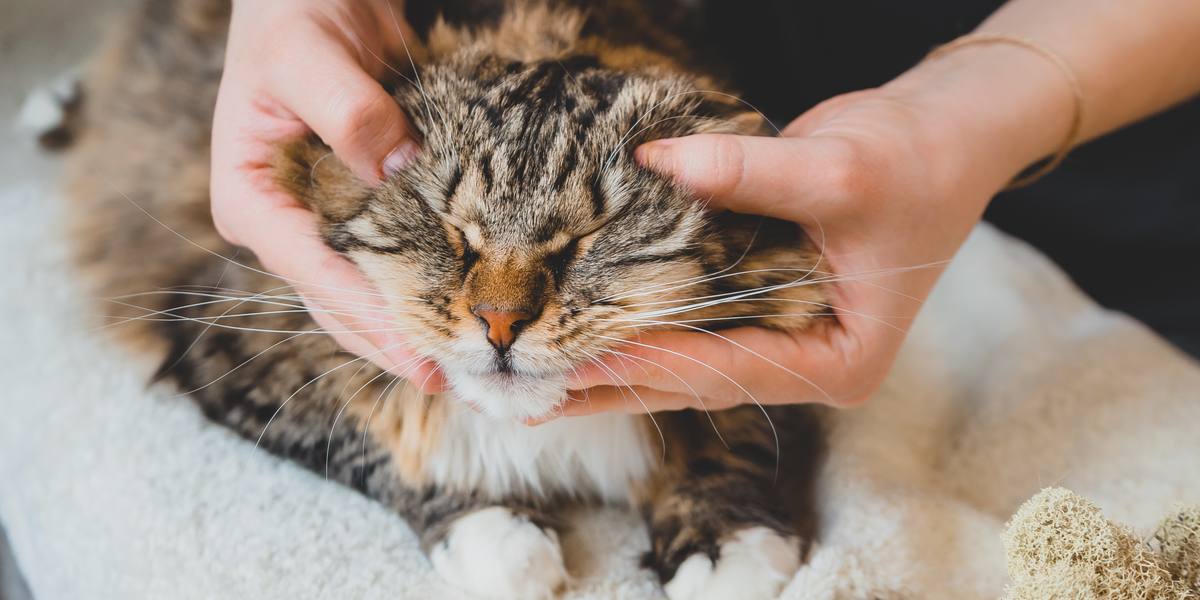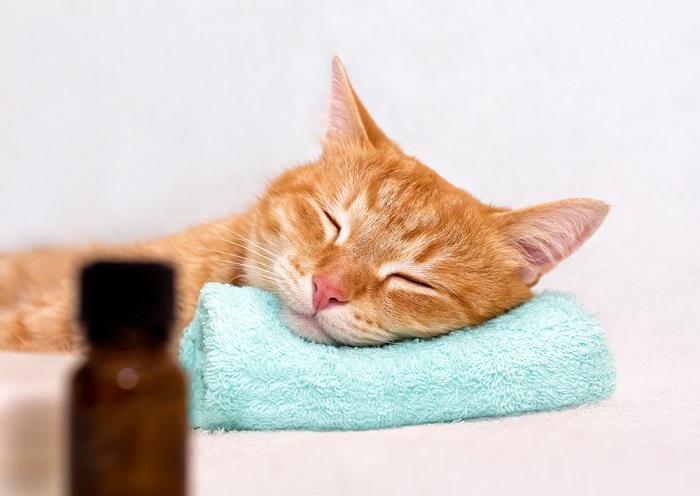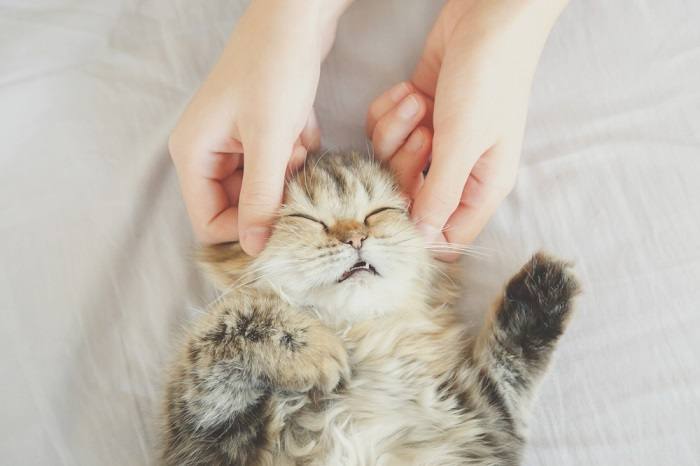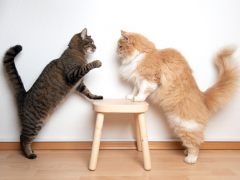
Ekaterina Kuzovkova / Shutterstock.com
Is chiropractic care for cats safe and effective? The thought of improving their quality of life without harsh drugs or surgery is certainly an attractive prospect. That’s why complementary therapies such as animal chiropractic care are becoming more popular.
Let’s talk through the facts so you can make the best decision for your cat and come prepared with all the right questions for your veterinarian.
Chiropractic Care for Cats
The chiropractic profession was first introduced in 1895. Although it has evolved significantly since then, it has always operated on the principle that misalignment of the spinal column (called vertebral subluxation) is responsible for ill health and disease.
Chiropractic theory suggests that misalignments of the spine cause pain, muscle tension, and reduced flexibility. These subluxations can put pressure on nearby nerves and interfere with normal function and the transfer of information around the body.
Dr. Catherine Foreman-Hesterberg is a veterinarian certified in chiropractic for animals. She describes animal chiropractic as the “diagnosis and treatment of vertebral subluxation complexes (VSC) and dysfunctional joints of the spine and extremities.”
Chiropractic treatment involves spinal manipulations to help restore proper alignment, improve range of motion, and relieve pressure on associated nerves. Veterinary chiropractors believe the practice has the following benefits:
- Relief of chronic pain that occurs with long-term conditions like osteoarthritis
- Relief of pain associated with injuries to muscles, ligaments, or joints
- Promotes fitness and mobility (especially in older patients)
- Speeds up recovery from injury or surgery
When Is Chiropractic Care Used on Cats?

Olga Smolyak / Shutterstock.com
In human health care, chiropractic treatment is used mostly to help with musculoskeletal issues, especially neck pain, back pain, and sports injuries. Dr. Foreman-Hesterberg explains that almost all species and ages can receive a chiropractic adjustment. “The animal just has to be receptive to the treatment and safe to work with.”
Veterinary chiropractic is used alongside conventional veterinary medicine to help treat problems such as:
- Osteoarthritis—A degenerative, inflammatory condition of the joints that is common in elderly cats.
- Hip dysplasia—This condition is more common in large, purebred, and overweight cats and can result in painful hip osteoarthritis.
- Spondylosis—A degenerative condition characterized by the formation of bone spurs on the vertebrae.
- Intervertebral disc disease—An uncommon but serious condition that causes pain, weakness, and even paralysis.
- Urinary incontinence—Cats that leak urine due to spinal damage or neurological disease.
Veterinary chiropractors may also utilize other complementary therapies alongside chiropractic such as acupuncture.
What To Expect
Veterinary chiropractic sessions involve a thorough review of health history and a complete physical exam. The chiropractor will palpate your cat’s joints, and if a correction is needed, they will apply a quick and gentle thrust to the affected area. Sedation or anesthesia are not typically used because they can affect the assessment and safety of the manipulation. Your cat’s instinct to resist that thrust is what prevents them from getting injured.
Even with the potential for some discomfort, Dr. Foreman-Hesterberg finds most of her patients to be cooperative. Immediate benefits for your cat make the adjustment worthwhile. “Areas that are misaligned can sometimes be painful to the animal,” she says, “However most animals will still allow me to adjust them, and they appear to feel much better afterward.” Some benefits she sees in small animals include improved gait and reduction in pain. Older pets may appear more active, playful, and have more stamina.
Lack of Research
There is a lot of debate about how effective chiropractic is, even in humans. Most success stories come from case reports or practitioners’ own observations—and mainly from horses, dogs, and laboratory animals.
While veterinarians practicing chiropractic see clear benefits for their patients, it’s important to keep in mind that there is a real lack of information about chiropractic in the veterinary research literature, especially in cats.
True research studies into the safety or effectiveness of animal chiropractic are rare and those studies that have been carried out have been criticized as being “of questionable quality, and fraught with serious methodological shortcomings”. [7] So far, scientists have failed to find evidence that so-called ‘vertebral subluxations’ exist, even using advanced imaging modalities such as x-rays or MRI scans.
Side Effects of Chiropractic Care for Cats
In people, chiropractic is considered safe when performed correctly by a trained and registered chiropractor. Negative effects are common but mild and include:
- soreness/discomfort
- stiffness
- headache
- lethargy/tiredness.
Serious side effects are rare but can be significant. This might include worsening a painful back or spinal condition to the point of losing neurologic function in one or more limbs.
When Cats Should Not Receive Chiropractic Care

Gumpanat / Shutterstock.com
There are definite instances where chiropractic care would NOT be safe to consider for your cat:
- Recent Trauma
- Fractures
- Tumors
- Bone Infections
- Herniated Discs
Always book a visit with your veterinarian for a check-up before considering alternative treatments such as chiropractic. [9]
For example, at the University of Illinois College of Veterinary Medicine, a pet with a primary neurologic condition must first be evaluated by a primary care veterinarian followed by a board-certified neurologist before Dr. Foreman-Hesterberg would be involved to provide chiropractic care.
If you plan to use additional or complementary therapies such as chiropractic for your cat, first consider:
- Is it appropriate for my cat’s condition? (speak to your veterinarian)
- Will my cat tolerate handling and manipulation without becoming stressed?
- What are the potential (and likely) benefits?
- What are the risks?
Remember, while anecdotal benefits may be seen on a case-by-case basis, there is no scientific evidence that chiropractic in cats is safe or effective. You must therefore carefully consider whether the risk of potential negative effects (stress, discomfort, more serious side effects) are worth taking for your cat.
There are many conventional treatments that are proven to reduce pain and inflammation in cats that your vet will recommend. Speak to your vet for advice.
Frequently Asked Questions
How do chiropractors adjust cats?
When you visit a chiropractor, they will start by taking a history to find out more about your cat’s condition, their general health and any treatments they are on. They will review any clinical notes provided by your cat’s veterinarian.
They will carry out a physical examination, paying special attention to your cat’s mobility (movement) and posture to try and identify the problem.
Once they have located what they believe to be the source of the problem, they will carry out a chiropractic adjustment. Chiropractic adjustments are low force, high velocity, thrust motions applied in a very specific location. The adjustments will probably need to be repeated – speak to the chiropractor about how many sessions might be needed and how often they should be performed.
How much does chiropractic in cats cost?
Most chiropractic adjustments are carried out over a period of weeks, requiring commitment to a course of treatment. Individual practitioners will set their own prices so the price of chiropractic treatment will vary. Contact your local animal chiropractor to find out their prices.
How do I know if my cat needs a chiropractor?
Chiropractic is most commonly used to treat pain. Signs of pain in cats can be subtle and difficult to spot, or simply dismissed as being “due to old age”.
Signs your cat might be in pain include:
- Not moving around as much
- Going outside less than normal
- Being less playful
- Toileting outside the litter box
- Lethargy
- Stiffness in the back legs
- Lameness, limping
- Vocalising
- Reluctance to be touched
- Muscle spasms
- Being slow to move especially after rest
- Reduced appetite
- Change in temperament or behaviour
- Reduced or excessive grooming
- Change in facial expression (squinty eyes, flat ears)
Always get any signs of pain or ill health in your cat checked out by a vet.
How do I find an animal chiropractor?
Your vet might be able to recommend and make a referral to a chiropractor. If sourcing one yourself, be sure to find someone who has undergone proper training.
Animal chiropractors registered with an association such as the American Veterinary Chiropractic Association or the International Veterinary Chiropractic Association must:
- Complete approved postgraduate veterinary chiropractic training
- Adhere to membership rules and regulations
Ensure the practice meets certain standards
I think my cat needs chiropractic adjustment – what should I do?
If you think your cat might be suffering from a problem that could be treated with chiropractic, first take them to see your veterinarian.
Your veterinarian will be able to:
- Examine your cat
- Help reach a diagnosis
- Identify conditions that may mean chiropractic manipulation is not safe for your cat
- Rule out other health problems
- Talk to you about conventional treatment methods
If you wish to use manual therapies such as chiropractic for your cat, you should only do so alongside conventional veterinary medicine and after discussion with your cat’s vet.
Although they are not without risk or side effects, medications and surgery have been tried and tested, and used to treat health conditions in cats with proven success. They should therefore always be considered first.
-
Homola, S. (2006). Chiropractic. Clinical Orthopaedics and Related Research, 444, 236–242. https://doi.org/10.1097/01.blo.0000200258.95865.87
-
Chiropractic adjustment for animals - Veterinary Medicine at Illinois. (2020, August 12). Veterinary Medicine at Illinois. https://vetmed.illinois.edu/pet-health-columns/chiropractic-adjustment-animals/
-
Admin, B.(2024, January 11). Home - International Veterinary Chiropractic Association. International Veterinary Chiropractic Association. https://ivca.de/
-
Dixon, P. Chiropractors for animals. The Royal College of Chiropractors. https://rcc-uk.org/wp-content/uploads/2016/02/Chiropractors-for-animals.pdf
-
Ernst, E. (2008). Chiropractic: a critical evaluation. Journal of Pain and Symptom Management, 35(5), 544–562. https://doi.org/10.1016/j.jpainsymman.2007.07.004
-
Johnson, K. A. (2018). Complementary and Alternative Veterinary Medicine: Where things stand for feline health. Science & Technology Libraries, 37(4), 338–376. https://doi.org/10.1080/0194262x.2018.1541430
-
International Veterinary Chiropractic Association. (2021, October 30). What is Veterinary Chiropractic? - International Veterinary Chiropractic Association. https://ivca.de/what-is-veterinary-chiropractic/
-
Migala, J. (2020, August 4). Quick Fixes for Everyday Aches and Pains. Everyday Health. https://www.everydayhealth.com/pain-management/all-articles/
-
The Royal College of Chiropractors. (n.d.). Chiropractors for Animals [Online PDF]. https://rcc-uk.org/wp-content/uploads/2016/02/Chiropractors-for-animals.pdf







